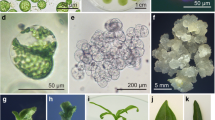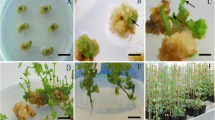Abstract
The possibility of scaling ploidy levels up and down offers several advantages for genetic studies and breeding work in potato. Shoot regeneration and chromosome doubling in plants regenerated fromin vitro cultures were investigated in 4 diploid (2n=2x=24) and 2 triploid (2n=3x=36) clones. Internode and leaf expiants were taken from plants propagated eitherin vitro as shoot cultures, orin vivo in a greenhouse. Two regeneration procedures were compared. Regeneration frequencies were significantly higher using a two-step regeneration protocol and from leaf explants, while doubling was more efficient starting fromin vivo grown plants. No doubling was observed in triploid clones. Considering altogether the percentage of regeneration and doubling, and the number of shoots regenerated per explant, the most efficient conditions were considered leaf explants taken fromin vivo grown plants, and cultured according to a two-step regeneration protocol.
Compendio
La posibilidad de llevar la ploidia a mayores o menores niveles ofrece varias ventajas para los estudios genéticos y trabajos de mejoramiento en papa. Se investigó la regeneratión de brotes y el doblaje de cromosomas en plantas regeneradas a partir de cultivosin vitro, en cuatro clones diploides (2n= 2x= 24) y en dos clones triploides (2n=3x=36). Se tomaron porciones de internudos y hojas de plantas propagadas ya seain vitro, como cultivo de brotes, oin vivo en un invernadero. Se compararon dos procedimientos de regeneración. Las frecuencias de regeneración fueron significativamente más altas utilizando un protocolo de regeneración de dos etapas cuando se utilizaron porciones de hojas, mientras que el doblaje de cromosomas fue más eficiente cuando se empezó con plantas que crecieronin vivo. No se observó doblaje en los clones triploides. Considerando en conjunto el porcentaje de regeneration y de doblaje y el número de brotes regenerados por porción, se consideró que las condiciones más eficientes se lograron con las porciones de hojas tomadas de plantas que crecieronin vivo y que fueron cultivadas de acuerdo a un protocolo de regeneratión de dos etapas.
Similar content being viewed by others
Abbreviations
- BAP:
-
benzylaminopurine
- GA3 :
-
gibberellic acid
- IAA:
-
indole-3-acetic acid
- NAA:
-
α-naphthaleneacetic acid
Literature Cited
Ancora, G. and K. Sree Ramulu. 1981. Plant regeneration fromin vitro cultures of stem internodes in self-incompatible triploidLycopersicon peruvianum Mill. and cytogenetic analysis of regenerated plants. Plant Sci Lett 22:197–204.
D’Amato, F. 1989. Polyploidy in cell differentiation. Caryologia 42:183–211.
Fish, N. and M.G.K. Jones. 1988. A comparison of tissue culture response between related tetraploid and dihaploidS. tuberosum genotypes. Plant Cell Tissue Organ Cult 15:201–210.
Gill, B.S., L.N.W. Kam-Morgan and J.F. Shepard. 1986. Origin of chromosomal and phenotypic variation in potato protoclones. J Hered 77:13–16.
Hermsen, J.G.Th., M.S. Ramanna, S. Roest and G.S. Bokelmann 1981. Chromosome doubling through adventitious shoot formation onin vitro cultivated leaf expiants from diploid interspecific potato hybrids. Euphytica 30:239–246.
Jacobsen, E. 1977. Doubling dihaploid potato clonesvia leaf tissue culture. Z Pflanzenzuchtg 80:80–82.
Jacobsen, E. 1981. Polyploidization in leaf callus tissue and in regenerated plants of dihaploid potato. Plant Cell Tissue Organ Cult 1:77–84.
Kaburu M’Ribu, H. and R.E. Veilleux. 1990. Effect of genotype, expiant, subculture interval and environmental conditions on regeneration of shoots from in vitro monoploids of a diploid potato species,Solanum phureja Juz & Buk. Factors affecting shoot regeneration of monoploid potato. Plant Cell Tissue Organ Cult. 23:171–179.
Karp, A., R. Risiott, M.G.K. Jones and S.W.J. Bright 1984. Chromosome doubling in monohaploid and dihaploid potatoes by regeneration from cultured leaf expiants. Plant Cell Tissue Organ Cult 3:363–373.
Kasperbauer, M.J. and G.B. Collins 1972. Reconstitution of diploids from leaf tissue of anther-derived haploids in tobacco. Crop Sci 12:98–101.
Murashige, T. and F. Skoog 1962. A revised medium for rapid growth and bioassays with tobacco tissue cultures. Physiol Plant 15:473–497.
Pijnacker, L.P., K. Sree Ramulu, P. Dijkhuis and M.A. Ferwerda. 1989. Flow cytometric and karyological analysis of polysomaty and polyploidization during callus formation from leaf segments of various potato genotypes. Theor Appl Genet 77:102–110.
Ramanna, M.S. and J.G.Th. Hermsen 1982. Gene transfer from non-tuberous to tuberousSolanum species: evidence from meiosis in hybrids. Euphytica 31:565–572.
Roest, S. and G.S. Bokelmann. 1980.In vitro adventitious bud techniques for vegetative propagation and mutation breeding of potato (Solanum tuberosum L.). 1. Vegetative propagationin vitro through adventitious shoot formation. Potato Res 23:167–181.
Ross, H.1986. Potato Breeding Problems and Perspectives. Verlay Paul Parey, Berlin and Hamburg. 132 pp.
Sonnino, A., M. Iwanaga and A. Henostroza 1988. Chromosome number doubling of 2x potato lines with diverse genetic background through tissue culture. Potato Res 31:627–631.
Sree Ramulu, K. 1987. Genetic instability during plant regeneration in potato: origin and implications. Plant Physiol (Life Sci Adv.) 6:211–218.
Sree Ramulu, K., P. Dijkhuis and S. Roest 1983. Phenotypic variation and ploidy level of plants regenerated from protoplasts of tetraploid potato (Solanum tuberosum L. cv. “Bintje”). Theor Appl Genet 65:329–338.
Sree Ramulu, K., P. Dijkhuis, S. Roest, G.S. Bokelmann and B.de Groot 1986. Variation in phenotype and chromosome number of plants regenerated from protoplasts of dihaploid and tetraploid potato. Plant Breeding 97:119–128.
Tempelaar, M.J., E. Jacobsen, M.A. Ferwerda and M. Hartogh 1985. Changes in ploidy level byin vitro culture of monohaploid and polyploid clones of potato. Z Pflanzenzuchtg 95:193–200.
Uijtewaal, B. A. 1987. Ploidy variability in greenhouse cultured andin vitro propagated potato (Solanum tuberosum) monohaploids (2n=x=12) as determined by flow cytometry. Plant Cell Rep 6:252–255.
Webb, K.J., E.O. Osifo and G.G. Henshaw. 1983. Shoot regeneration from leaflet discs of six cultivars of potato (Solanum tuberosum subsp.tuberosum). Plant Sci Lett 30:1–8.
Wheeler, V.A., N.E. Evans, D. Foulger, K.J. Webb, A. Karp, J. Franklin and S.J.W. Bright 1985. Shoot formation from expiant cultures of fourteen potato cultivars and studies on the cytology and morphology of regenerated plants. Ann Bot 55:309–320.
Author information
Authors and Affiliations
Additional information
Contribution no. 83 from Research Center for Vegetable Breeding — CNR.
Rights and permissions
About this article
Cite this article
Cardi, T., Carputo, D. & Frusciante, L. In vitro shoot regeneration and chromosome doubling in 2X and 3X potato clones. American Potato Journal 69, 1–12 (1992). https://doi.org/10.1007/BF02853404
Accepted:
Issue Date:
DOI: https://doi.org/10.1007/BF02853404




